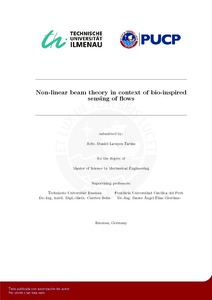| dc.contributor.advisor | Behn, Carsten | |
| dc.contributor.advisor | Elías Giordano, Dante Ángel | |
| dc.contributor.author | Lavayen Farfán, Daniel | es_ES |
| dc.date.accessioned | 2017-03-31T20:43:22Z | es_ES |
| dc.date.available | 2017-03-31T20:43:22Z | es_ES |
| dc.date.created | 2016 | es_ES |
| dc.date.issued | 2017-03-31 | es_ES |
| dc.identifier.uri | http://hdl.handle.net/20.500.12404/8324 | |
| dc.description.abstract | The thesis at hand is part of a research project that attempts to study and develop
vibrissa inspired tactile sensors for object and fluid flow detection. The main focus of the thesis
is on the development of a model for a vibrissa-like sensor for obstacle contour recognition under
fluid loads. To this end, a mechanical model – based on the non-linear Euler-Bernoulli beam theory
– is established. The model includes the main characteristics found in a natural vibrissa, such as
elasticity of the base, that acts as the vibrissa follicle; the intrinsic curvature; and conicity.
The characteristics are represented as parameters of the model. The model is subjected to a contact
load and a fluid flow load, represented by a concentrated load and a distributed load,
respectively. Then, the model is transformed into a dimensionless representation for further
studies to achieve more general assertions. A variation of the magnitude of these loads, as well as
the vibrissa parameters is also analyzed. A direct numerical approximation using the finite
difference method, along with the shooting method, is used to obtain a solution of the model.
Subsequently, the model is used to simulate an ideal contact between an obstacle and the vibrissa.
This simulation considers a quasi-static sweep of the artificial vibrissa with the contour of a
profile, while measuring and recording the forces and moment at the base. This procedure is then
repeated in combination of a distributed force acting on the vibrissa, simulating the effect of a
fluid flow. Two types of contact phases are identified and the conditions for each one are set.
Finally, the measured quantities, which represent the observables an animal solely relies on, are
used to obtain the magnitude of the fluid load and to reconstruct the profile contour of the
obstacle. The developed model is used again for the reconstruction, an analysis of the observables
is performed to identify and predict which contact phase the vibrissa is in. The results
successfully show identification of the fluid flow load as well as reconstruction of the profile,
the difference between the reconstructed profile and the
original profile is then calculated as a measure of reconstruction quality. | es_ES |
| dc.description.uri | Tesis | es_ES |
| dc.language.iso | eng | es_ES |
| dc.publisher | Pontificia Universidad Católica del Perú | es_ES |
| dc.rights | Atribución-NoComercial-SinDerivadas 2.5 Perú | * |
| dc.rights | info:eu-repo/semantics/openAccess | es_ES |
| dc.rights.uri | http://creativecommons.org/licenses/by-nc-nd/2.5/pe/ | * |
| dc.subject | Teoría de las haces | es_ES |
| dc.subject | Materiales biomédicos | es_ES |
| dc.title | Non-linear beam theory in context of bio-inspired sensing of flows | es_ES |
| dc.type | info:eu-repo/semantics/masterThesis | es_ES |
| thesis.degree.name | Magíster en Ingeniería Mecánica | es_ES |
| thesis.degree.level | Maestría | es_ES |
| thesis.degree.grantor | Pontificia Universidad Católica del Perú. Escuela de Posgrado | es_ES |
| thesis.degree.discipline | Ingeniería Mecánica | es_ES |
| renati.advisor.dni | 10142907 | |
| renati.discipline | 713347 | es_ES |
| renati.level | https://purl.org/pe-repo/renati/level#maestro | es_ES |
| renati.type | http://purl.org/pe-repo/renati/type#tesis | es_ES |
| dc.publisher.country | PE | es_ES |
| dc.subject.ocde | https://purl.org/pe-repo/ocde/ford#2.03.01 | es_ES |






